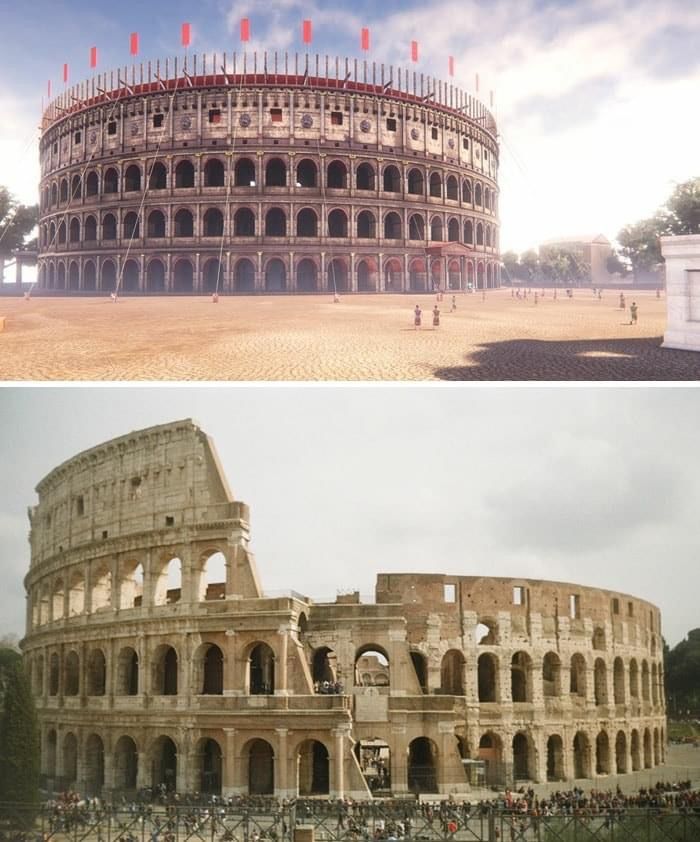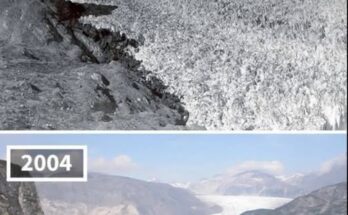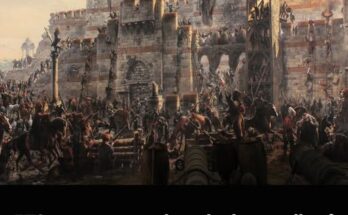
In 2023, scientists finally cracked the code behind one of history’s most enduring mysteries: how ancient Roman concrete has withstood the test of time while modern concrete often crumbles within decades. The secret? Self-healing concrete—a revolutionary material quietly perfected over 2,000 years ago.
Unlike today’s formulations, which tend to degrade under stress and moisture, Roman builders engineered their concrete with an ingenious twist: they included chunks of reactive lime, known as quicklime, in their mix. These seemingly random white inclusions, once considered flaws, are now understood to be the key to the material’s longevity.
When a crack forms and water seeps into the concrete, it triggers a chemical reaction with the lime. The result? New mineral growth that seals the fracture from within, restoring the concrete’s strength and preventing further damage. In effect, the concrete repairs itself—naturally and silently—over time.
This discovery, published in Science Advances (2023) and spearheaded by researchers at MIT and collaborators from Europe, repositions the Romans not just as master builders, but as early materials scientists. Their methods, lost for centuries, are now informing new approaches to sustainable and durable construction. Modern engineers are already experimenting with Roman-inspired formulations to create next-generation concrete that could last for centuries rather than decades.
It’s why architectural wonders like the Pantheon, Roman aqueducts, and ancient harbors still stand today with minimal degradation, even after earthquakes, wars, and centuries of weathering. Their durability wasn’t magic—it was meticulous, science-backed craftsmanship.
In an era grappling with infrastructure decay and climate change, the revival of Rome’s forgotten genius offers not just a lesson in history, but a blueprint for building a more resilient future.
In the shadow of towering aqueducts, resilient sea walls, and the unmatched dome of the Pantheon, a 2,000-year-old secret has quietly endured. While many modern structures show signs of decay within just a few decades, the architectural marvels of ancient Rome still stand proud—solid, defiant, and seemingly impervious to time. For years, scientists, engineers, and historians have marveled at this mystery: what made Roman concrete so durable?
In 2023, researchers from MIT, Harvard, and European institutions finally uncovered a key part of the answer. Their findings, published in Science Advances, confirm what many had long suspected—Roman builders weren’t just skilled with stone and structure; they were master chemists. Their use of self-healing concrete—a blend so sophisticated it could repair itself over time—redefines how we think about ancient materials science. And now, this ancient innovation is poised to revolutionize the future of construction in a world desperate for sustainable and durable infrastructure.
I. The Modern Concrete Problem
To appreciate the brilliance of Roman engineering, we must first confront the flaws in our own. Modern concrete, a blend of cement, sand, gravel, and water, is the most widely used man-made material in the world. It forms the backbone of our cities, bridges, dams, and highways. Yet despite its ubiquity, modern concrete is far from perfect.
Concrete begins to degrade from the moment it is exposed to the elements. Cracks form due to thermal expansion, moisture infiltration, or structural stress. Once these microfractures appear, water seeps in, rusts the steel rebar inside, and accelerates internal decay. In coastal or seismic zones, the deterioration process is even faster. Repairing and maintaining concrete infrastructure has become a massive global burden, costing billions each year.
By contrast, the Romans built with durability as a guiding principle. They didn’t have steel rebar. They didn’t rely on high-tech additives or synthetic reinforcements. And yet, their structures have withstood time, nature, and the rise and fall of civilizations.
II. The Ancient Formula: Pozzolanic Magic and Quicklime
The durability of Roman concrete begins with its unique composition. The Romans used a volcanic ash called pozzolana, sourced from regions like Pozzuoli near Naples, and mixed it with lime (calcium oxide) and seawater to create a binder. This combination produced a strong, chemically stable material. But recent discoveries show that one particular ingredient had been overlooked or misunderstood for centuries: quicklime, or unslaked lime.
Modern interpretations of Roman concrete suggested that the inclusion of lime clasts—white mineral chunks often found in ancient samples—were unintentional, even viewed as flaws or inconsistencies in the mix. But the 2023 study turned that theory on its head.
Using microscopic analysis, scanning electron microscopy (SEM), and advanced imaging, researchers found that these lime clasts weren’t accidents at all—they were deliberately included, and they held the key to self-healing properties.
When cracks form and water enters the concrete, it dissolves parts of the lime clasts. This starts a process called pozzolanic reaction, which triggers the recrystallization of calcium carbonate—a mineral that fills in the cracks and effectively seals them shut. This “self-healing” process can occur again and again, making the structure increasingly resilient over time.
III. Case Studies: The Pantheon, Aqueducts, and Sea Walls
The most compelling evidence of Roman concrete’s endurance lies in its architecture. The Pantheon in Rome, completed around 126 AD, boasts the world’s largest unreinforced concrete dome. Despite nearly two millennia of earthquakes, floods, and the wear of time, it remains largely intact.
Roman aqueducts, designed to carry water across long distances, were built with similar concrete. Many sections are still standing—some even still channeling water. These aqueducts weren’t just durable; they were built to last beyond the lifetimes of their builders, a concept largely foreign to today’s fast-build, fast-degrade approach.
Then there are the marine structures—perhaps the most remarkable of all. Roman harbors, like those at Caesarea Maritima and Cosa, were constructed with underwater concrete that has hardened over time. Most modern underwater concrete degrades rapidly due to saltwater corrosion. But Roman harbor concrete remains chemically stable, thanks to interactions between volcanic ash and seawater, forming durable aluminous tobermorite crystals.
These long-lasting structures serve not only as historical relics but as real-world proof of material science mastery.
IV. The Rediscovery: Modern Science Meets Ancient Wisdom
The 2023 breakthrough came from a team of interdisciplinary scientists. By studying Roman concrete samples with powerful modern tools, they discovered that ancient builders engaged in “hot mixing,” a process in which quicklime was added to the concrete mix at high temperatures. This caused a highly exothermic reaction, distributing the lime clasts throughout the mix in a reactive, accessible form.
More importantly, these lime clasts remained dormant until cracks and water infiltration activated them. The water-reactive clasts could then dissolve and recrystallize within fractures, mimicking a form of biological healing in an inorganic material.
This finding has shifted the narrative: ancient Roman builders weren’t merely lucky or practical; they were employing an intentional, sophisticated technique far ahead of its time. It’s now clear they understood that a structure’s endurance wasn’t just a matter of strength, but of adaptability and repair.
V. Implications for Today: Building for the Future
The world is currently facing an infrastructure crisis. Roads, bridges, buildings, and dams are failing faster than they can be rebuilt. Climate change, sea-level rise, and increased urbanization are putting additional strain on our aging systems. The construction industry is also one of the largest contributors to global CO₂ emissions, largely due to the production of cement.
Rediscovering and adapting Roman concrete could change everything.
- Durability: Self-healing concrete could extend the lifespan of structures from decades to centuries, drastically reducing maintenance costs and waste.
- Sustainability: Roman concrete required lower temperatures for production, meaning fewer emissions compared to modern Portland cement.
- Seawater Compatibility: With sea levels rising and coastal development expanding, Roman-style marine concrete could offer a sustainable alternative for harbor and sea wall construction.
- Reduced Carbon Footprint: By shifting away from energy-intensive cement production and embracing volcanic ash or similar pozzolanic materials, we could cut down on one of the most carbon-heavy industrial processes.
Some companies are already experimenting with bio-based self-healing concretes, such as those using bacteria to fill cracks. But the Roman method offers a purely chemical, passive solution—no added organisms, no electronics, no need for external triggers.
VI. From Ruins to Renaissance: Cultural and Philosophical Lessons
The story of Roman concrete is more than just a scientific breakthrough—it’s a cultural awakening. It challenges our assumptions about ancient knowledge and our modern superiority complex. We often view progress as linear, assuming that the past was always less advanced. But in rediscovering Roman concrete, we are reminded that technological wisdom can be lost as easily as it is gained.
Why did we lose this knowledge in the first place?
As the Roman Empire collapsed and Europe entered the Middle Ages, many techniques were forgotten. The urgency of survival replaced the luxury of long-term planning. Architectural knowledge was fragmented, passed down without the scientific literacy to explain why certain methods worked. The lime clasts were still visible in ruins, but their purpose went unnoticed for centuries.
Today, as we reclaim this ancient knowledge, we must also reclaim the mindset behind it—a philosophy of building for generations, not just decades. The Romans constructed their cities as legacies. In contrast, modern development often prioritizes speed, cost, and short-term utility. If we truly want to create a sustainable civilization, we must embrace the Roman principle of durability as design.
VII. Moving Forward: Can We Build Like Romans Again?
Bringing Roman-style concrete into modern construction isn’t as simple as replicating old recipes. Sourcing volcanic ash, adapting hot-mixing techniques, and understanding how the material behaves in different environments are all challenges to be addressed. Yet, several research institutions and companies are actively working on Neo-Roman concrete prototypes, using local pozzolans and modified production processes.
In 2023, MIT’s Materials Systems Laboratory began collaborating with construction firms to test Roman-inspired mixes in real-world applications. Pilot projects include road slabs, bridge decks, and coastal reinforcements using these ancient techniques.
If successful, the impact could be global—offering developing countries affordable, long-lasting materials; helping coastal cities adapt to climate change; and even providing more durable materials for off-world construction, such as habitats on Mars, where long-term durability and resilience are essential.
VIII. Conclusion: The Concrete Connection Between Past and Future
Mary Walton’s noise-reduction inventions. Nikola Tesla’s alternating current systems. Now, Roman self-healing concrete. Throughout history, many moments of brilliance were buried, forgotten, or overshadowed—only to resurface when the world needed them most.
The rediscovery of Roman concrete is not just a victory for archaeology or materials science. It is a reminder of human ingenuity, of the ability to engineer with nature rather than against it, and of the value of looking backward to move forward.
The Romans may have vanished, but their buildings—and now their science—remain. In a world faced with environmental fragility and infrastructure decay, perhaps the most radical act is not to invent something new, but to revive something ancient.
The future of concrete may well lie in the ashes of a Roman volcano—and in the wisdom of those who understood, 2,000 years ago, that the best way to build is to build to last.


